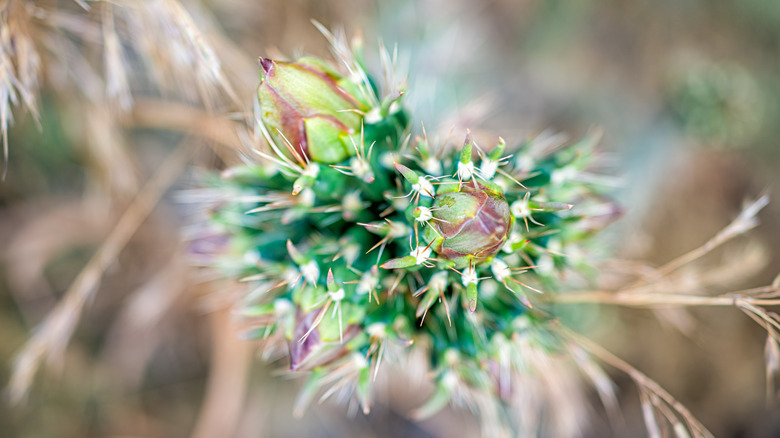The Cactus Fruit That Tastes Just Like Asparagus
The cactus might be the most misunderstood member of the plant family. The first humans to encounter one in the wild likely attributed its sharp spikes to some sort of evolutionary trait for survival, like the quills on a porcupine that stick up in the face of a predator. Oddly enough, Vermont Public says cacti's built-in shield of needles is actually just a way for them to withstand harsh desert climates.
Some species of cacti are simply meant to be admired, while others bear a host of fruitful properties beneath their layer of blood-drawing glochidia. Modern Farmer lists five such varieties, all of which you can grow yourself. Among them are dragon fruit, which evokes flavors of pear and kiwi, and prickly pear, which lands somewhere in the middle of watermelon and bubble gum, per Spoon University. If those sound too sweet for your liking, let us turn your attention to a cactus whose buds yield a familiar vegetal flavor.
Don't sleep on cholla buds
Cholla cacti pepper vast swaths of the Sonoran desert, which winds through parts of northern Mexico and the Southwestern United States. According to Atlas Obscura, the Tohono O'odham tribe has been making use of the cholla's tasty flowered buds (which they call ciolim) for hundreds of years, if not longer. It's not like picking a handful of berries, though. Per the outlet, tribe members learned that removing the spikes from the calcium-rich yellow buds and cooking down the fruit yields a "tender treat reminiscent of an artichoke heart," which tastes a bit like asparagus with a hint of lemon.
Cholla season — which typically happens in April — is all too brief, leading foragers to dry their harvests and rehydrate them for use in off-seasons. Hank Shaw of Honest Food writes that the cholla's buckhorn, staghorn, and pencil varieties are the most popular for eating. He adds that cholla might be one of the pokiest cacti around, so be sure to bring gloves if you decide to go foraging in the desert.
How to harvest and prepare cholla buds
If you're ready to start cooking with nutritious, flavorful cholla buds and you happen to live near their native Sonoran desert, Velvet Button of Phoenix's Ramona Farms has a Taste Makers guide for how to safely forage them in small quantities. First, she uses a leafy branch as a makeshift brush with which to clean off the largest spikes of her modest haul. Then, she transfers the buds to a metal sieve and shakes them around, using a second sieve to prevent them from flying, and allows any leftover spikes to drop through.
Once you have your spike-free buds, which look something like tiny artichokes, it's time to prepare them for cooking. Slow Food Phoenix board member Cristal Franco suggests chopping them up (either fresh or rehydrated) and adding them to omelettes and burritos, or tossing them into salads whole. Of course, you could also treat them like asparagus by blanching or roasting them with your favorite spices.


